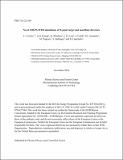| dc.contributor.author | Cowley, C. | en_US |
| dc.contributor.author | Kuang, Adam Q. | en_US |
| dc.contributor.author | Moulton, D. | en_US |
| dc.contributor.author | Lore, J.D. | en_US |
| dc.contributor.author | Canik, J. | en_US |
| dc.contributor.author | Umansky, M. | en_US |
| dc.contributor.author | Wigram, Mike | en_US |
| dc.contributor.author | Ballinger, S. | en_US |
| dc.contributor.author | Lipschulz, B. | en_US |
| dc.date.accessioned | 2025-03-21T20:23:53Z | |
| dc.date.available | 2025-03-21T20:23:53Z | |
| dc.date.issued | 2022-11 | |
| dc.identifier | 22ja109 | |
| dc.identifier.uri | https://hdl.handle.net/1721.1/158746 | |
| dc.description | Submitted for publication in Plasma Physics and Controlled Fusion | |
| dc.description.abstract | The design and understanding of alternative divertor configurations may be crucial for achieving acceptable steady-state heat and particle material loads for magnetic confinement fusion reactors. Multiple X-point alternative divertor geometries such as snowflakes and X-point targets have great potential in reducing power loads, but have not yet been simulated widely in codes with kinetic neutrals. This paper discusses recent changes made to the SOLPS-ITER code to allow for the simulation of X-point target and low-field side snowflake divertor geometries. Snowflake simulations using this method are presented, in addition to the first SOLPS-ITER simulation of the X-point target. Analysis of these results show reasonable consistency with the simple modelling and theoretical predictions, supporting the validity of the methodology implemented. | |
| dc.publisher | IOP | en_US |
| dc.relation.isversionof | doi.org/10.1088/1361-6587/acb4ba | |
| dc.source | Plasma Science and Fusion Center | en_US |
| dc.title | Novel SOLPS-ITER simulations of X-point target and snowflake divertors | en_US |
| dc.type | Article | en_US |
| dc.contributor.department | Massachusetts Institute of Technology. Plasma Science and Fusion Center | |
| dc.relation.journal | Plasma Physics and Controlled Fusion | |
